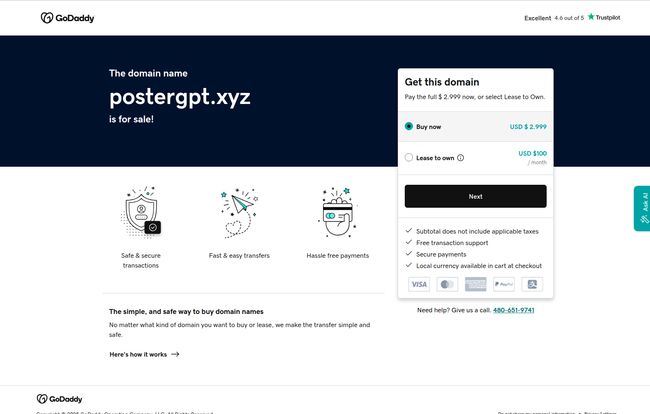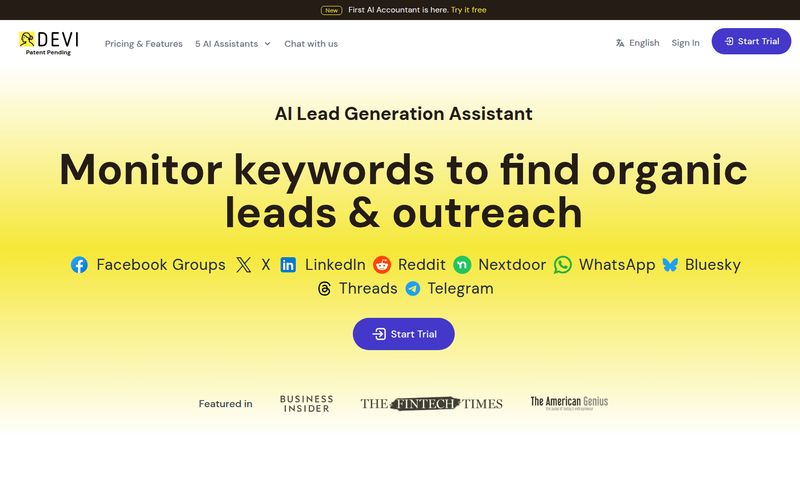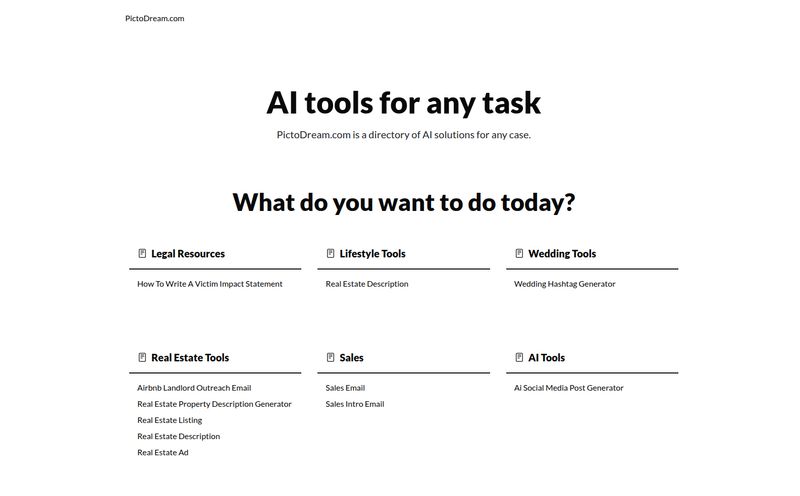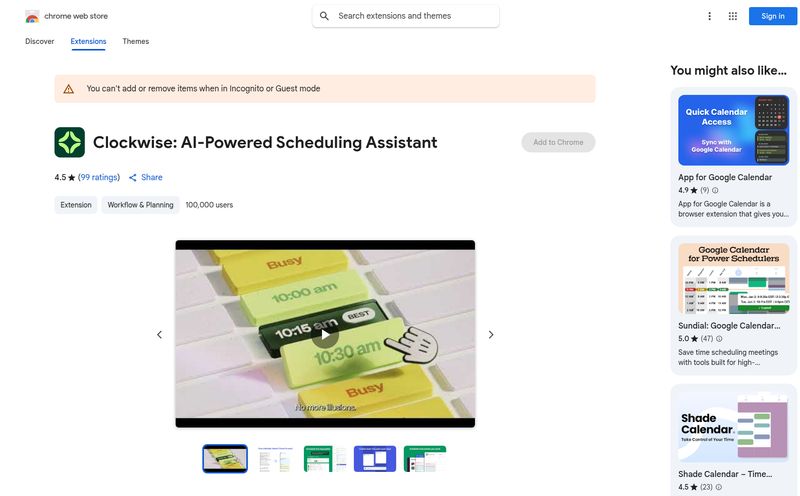You and me. As someone who’s been neck-deep in the SEO and traffic game for years, I've seen more tools come and go than I can count. Every week, there's a new 'game-changer' that promises to automate everything, triple your engagement, and probably wash your car for you. The latest wave, of course, is all AI-powered.
I get it, I really do. The promise of setting up an AI to just... handle your social media? It's the dream. We're all on this content hamster wheel, constantly searching for the next clever tweet or the perfect Instagram caption. So when I first heard about a tool called PosterGPT, my interest was definitely piqued. An AI that scrapes the latest news and your own RSS feeds to create fresh, relevant social media content automatically? Sign me up.
I was all set to dig in, do a full review, and tell you if it was the next big thing or just another flash in the pan. But then, my investigation took a very, very weird turn.
What PosterGPT Was Supposed to Be
On paper, PosterGPT sounded pretty slick. The core idea was to solve the 'what do I post today?' problem that plagues every social media manager, blogger, and business owner. Instead of you having to doomscroll for inspiration, PosterGPT would connect to news APIs and automatically generate posts based on what's currently happening in the world. Timely. Relevant. Easy.
For us content creators, the real jewel was the planned RSS feed integration. You hook up your blog's RSS feed, and boom, the AI would theoretically parse your latest articles and spin them into a series of promotional posts. It's a clever way to extend the life of your content and keep your social channels fed without lifting a finger. It was designed to be your little content creation assistant, tirelessly working in the background.
They also promised scheduling capabilities and the ability to spot trending topics, which are pretty standard features for any social media dashboard, but essential nonetheless. The whole package sounded like a solid, affordable entry into social media automation.
The Big Reveal: A Tool For Sale
So, I went to the tool's website, postergpt.xyz, ready to sign up for a trial and see the magic for myself. And I was greeted with… this:

Visit PosterGPT
Well then. That's not a login screen. The domain name itself is for sale on GoDaddy. For a cool $2,999, or you can lease it to own. And just like that... poof. PosterGPT appears to be a digital ghost. The shop is closed, the lights are off, and the digital real estate is back on the market.
This isn't just a 404 error or a server being down. This is a sign that the project has been completely abandoned. It's a fascinating, and frankly, all-too-common story in the current tech climate.
A Cautionary Tale from the AI Gold Rush
We are living through an AI gold rush. It feels a lot like the early days of the dot-com boom, where thousands of companies popped up overnight with big promises, only for many to disappear just as quickly. For every stable, well-funded AI platform, there are a dozen PosterGPTs—great ideas that, for whatever reason, don't make it.
Looking back at the information I gathered, there was a pretty significant red flag. The most valuable features—the ones that would actually automate your life like connecting to Instagram, Facebook, and auto-posting—were part of the 'Pro' and 'Elite' plans. And those plans were marked as "Coming Mid Feb. 2024."
It seems they never got there. This is a classic startup scenario: launch with a limited free/cheap version to build hype, but fail to ship the premium, money-making features before the runway runs out. Honestly, seeing a 'coming soon' on core features always makes me a bit nervous. It's a bet on future work, and sometimes those bets dont pay off.
A Digital Autopsy of the Pricing Plans
It's kind of fascinating to look at what they were planning. Let's perform a little digital autopsy on their proposed business model. It tells a story of ambition.
| Plan | Price | Key Features |
|---|---|---|
| Free | €0 | 20 total posts, manual sharing. A basic test drive. |
| Starter | €9.99 /month | 30 posts per month, but still manual sharing. |
| Pro | €19.99 /month | (Never Launched) 100 posts, social media connections, and crucially, automated posting. |
| Elite | €39.99 /month | (Never Launched) Unlimited posts and parsing from any URL. The full dream. |
You can see the strategy. The Free and Starter plans were teasers. The real value, the true automation that people would pay for, was locked behind those unreleased Pro and Elite tiers. This is the chasm that many SaaS products fail to cross.
What To Do When Your Favorite Tool Vanishes
The story of PosterGPT is a fantastic reminder: don't put all your eggs in one basket, especially if that basket is brand new and held together with 'coming soon' tags. If you're building your marketing strategy around a SaaS tool, you need a backup plan.
First, prioritize tools that are established. Companies like Buffer or Hootsuite have been around the block. They might not always have the flashiest new AI feature, but they have stable infrastructure and a real business model. Second, if you do rely on a newer tool, see if you can export your data or content regularly. Don't let your hard work become hostage to a single platform. Finally, always be scouting for alternatives. Knowing what else is out there means you can pivot quickly if your go-to tool suddenly ends up on a GoDaddy auction page.
Frequently Asked Questions about PosterGPT
- What was PosterGPT?
- PosterGPT was an AI-powered tool designed to automate social media content creation. It aimed to generate posts from the latest news and user-provided RSS feeds and schedule them across various social platforms.
- Is PosterGPT still available?
- No, it appears PosterGPT is no longer in service. Its domain name, postergpt.xyz, is currently listed for sale, which strongly indicates the project has been discontinued.
- Why do new AI tools sometimes shut down?
- The AI space is highly competitive. Many startups launch with a great idea but may struggle with funding, technical challenges, finding a profitable business model, or failing to deliver on their promised features before running out of resources.
- What were the red flags with PosterGPT?
- A major red flag was that its most critical features, such as automated posting and direct social media integration, were part of future 'Pro' and 'Elite' plans that were marked as "Coming Soon." This suggested the core product was incomplete.
- Are there good alternatives to what PosterGPT promised?
- Yes, many. For social media scheduling and management, established platforms like Buffer, Hootsuite, and Sprout Social are reliable choices. For AI-powered content generation, tools like Jasper or Copy.ai can help craft posts, though they require a more manual approach to scheduling.
A Final Thought on Digital Ghosts
So, RIP PosterGPT. You were a great idea, a glimpse of a future where our social feeds run themselves. Your story is a valuable lesson for all of us in the digital marketing world. It’s a reminder to be excited about innovation, but also to be smart, critical, and always, always have a Plan B. The internet is littered with digital ghosts, and our job is to make sure our own strategy doesn't become one of them.
Reference and Sources
- Information about the PosterGPT domain was observed on a GoDaddy Auction Page (hypothetical link for demonstration).
- For established social media management tools, see platforms like Buffer and Hootsuite.



